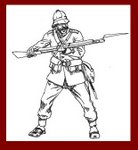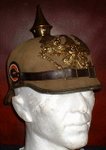
Somewhere in Russia 1919
By Greg Novak
Designer Notes
This project started due to the fact that I have a nice collection of Russian Civil War 20mm figures. I have used them with Command Decision in the past but rarely have had a chance to use at conventions games. My interest was in doing a multi side game with less of an emphasis on the tactical system and more on a system that would be easy to teach to novice miniature players. V & B with its move countermove system is easier to teach and the fact that the Mid West HMGS Little Wars: has a theme of "Civil Wars" was enough to push me into gear to try things out.
Troop and Stand Sizes
Based on the fact that I wanted to have players running brigade commands, I decided that I would use a ground scale of 1" equals 50 yards, and 1 SP equals 80 men or two weapons. Infantry stands would be regimental sized, 3" by 1.5", and have 2 to 3 SP¹s with five to seven figures per stand.
Detachments are have stands 1.5" by 1" of 1 SP, and are used for holding trenches. They have three figures each. I have some magnetic stands which allow me to put two detachments together to make a regular infantry stand. Cavalry stands would be of a similar size, and have 2 SP's per stand with three to four figures a stand. Machine gun and artillery stands would be 1.5" by 1.5" and be of 2 SP's each, with two to three figures per stand.
Armored trains would have one to two cars for each train, while armored cars and light tanks are on stands 1.5" wide by 3" deep, as are machine gun carts.
Medium tanks are on 3" by 3" stands. Vehicle stands are usually of 2 SP's each. Commanders are represented at the battalion level (UC or DC), brigade level (CC) and army commander and are mounted on washers.
While a full strength battalion can have three to four infantry stands, my RCW armies also have battalions of two stands, or even one stand. Hence the use of DC for of the larger formations, and UC for the smaller units.
For the record, while Red¹s and White¹s are easy to understand I have added in the Green¹s local independents Poles, Cossacks and others as well as the Blues our foreign interventionists British American Canadians - French and Czech's with some interest in adding others. My prize unit is a battalion of "Balts" under the command of a British officer the British government funded several German Freikorps for service in Russia but to avoid public embarrassment these units were christened as "Balts".
Would be interested in comments and feedback.
Sequence of Play:
The White/Blue side goes first, though all five phases listed below.
Then the Red/Green side follows in turn.
- A. Command Determination
- B. Movement
- C. Rally
- D. Morale Checks for both sides
- E. Combat for both sides
Command Control:
Stands within 6² of a superior officer are in command. Units not within 6" of a superior officer may only move half of their total movement allowance; may not recover from disorder; will be placed in disorder if they move, and may never move towards a visible enemy unit.
All armored cars and tanks are considered as self-ordering, they are always in command and can recover from disorder on their own.
Movement:
All non-poorly trained stands are allowed a free facing. The second facing costs 50% of the unit¹s movement. A player may change facing without paying the 50% cost, but the unit will be disordered. A poorly trained stand, which changes facing, does so at a cost of 50% of the unit¹s movement.
For a unit to reform from disorder costs 50% of the units movement.
Limbering and unlimbering are both considered a change of facing but only horse artillery may do both in the same turn.
Movement Rates:
- Infantry Stands 16"
- Mounted Cavalry Stands 24"
- Medium Machine Gun Stands 12"
- Light Machine Gun Stands 16"
- Machine Gun Carts 20"
- Motorized Vehicles 24"
- Light Tanks 12"
- Heavy Tanks 8"
- Armored Trains 32"
- Mortars 12"
- Limbered Heavy Artillery 12"
- Limbered Field Artillery 16"
- Limbered Horse Field Artillery 20"
- Carts 16"
- Wagons 12"
- Commanders 24"
Terrain Costs:
Road March: All stands may move in travel march along roads at a rate of triple speed, or cross-country at double speed. It takes one half turn to recover from travel march, and the stands if attacked may not fight back Motorized Vehicles on roads move 2" for every 1" of movement moved. They may freely follow roads without having to pay costs for any twists or turns along the road. This movement is in addition to the use of travel march used by vehicles and these units may engage in combat.
Armored Trains: Armored Trains wishing to engage in combat must move at half speed or less.
Built Up Terrain: All non-vehicle stands moving into a built up areas do so at a cost of 50% of their movement and are disordered on the turn that they enter the area. Stands, which are marching through a town, do not pay this penalty.
Streams All stands pay half of their movement to cross the stream. Vehicles may only cross at marked fords or bridges.
Marsh: Units crossing a marsh lose half their movement and are disordered while crossing. Vehicles may not enter a Marsh.
Woods: All non-vehicle stands pay 2" for every 1" moved in woods. In addition, all stands may not recover from disorder unless on an edge of a wooded area. Vehicle stands including tanks pay 4" for every 1" moved in woods.
Barbed Wire: Wheeled vehicles and mounted units cannot cross barbed wire. Infantry and machine gun stands may cross barbed wire at a cost of 50% of their movement, and are disordered. Tanks can cross barbed wire, and remove a 3" segment of wire at the point that they cross.
Trenches: wheeled vehicles may not cross Trenches. Mounted units can cross a trench at the cost of 50% movement, and are disordered after crossing,
Rally:
Routed units, which are in contact with a superior officer, may be rallied at this point. Routed units may make a free facing as part of the rally, but may not otherwise move. Rallied units are considered permanently disordered for the remainder of the game.
Morale:
All stands which are in contact with an enemy stand, or which are within close range of any enemy infantry and artillery stand must check morale. The unit¹s morale number is modified by the following:
To pass a morale check, roll a D6 for equal or less than the units modified morale number.
- Infantry/Artillery defending high ground and stationary +1
- Meleeing enemy unit in flank +1
- Army or Corps Commander attached to unit +1
- Unit in works +1
- Unit in trenches +2
- Disordered -1
- Meleeing Artillery/Machine Guns from front -1
- Attacked by mounted cavalry* -1
- Attacked from the flank -2
- Enemy tank within 4" -2
Infantry or machine gun stands which pass their morale against enemy cavalry will get a +1 to their defensive fire in melee.
Combat:
All stands roll the following number of die for attacks and counterattacks:
Infantry Stands roll three (3) dice in melee and in fire. If the infantry stand is stationary, it will roll an additional three (3) dice for melee and fire.
Detachments roll one (1) dice in melee and in fire. If the detachment is stationary, it will roll an additional one (1) dice for melee and fire.
Light Machine Gun Stands roll two (2) dice in melee and in fire. If the stand is stationary, it will roll an additional one (1) dice for melee and fire.
Medium Machine Gun Stands may only fire if they do not move; they roll three (3) dice for both fire and melee. They gain one (1) if they are stationary.
Medium Machine Gun Carts may fire if they move; they roll two (2) dice for both fire and melee. They may not go stationary.
Mounted Cavalry Stands roll two (2) dice for melee. They may not fire mounted.
Massed Mounted Cavalry Stands roll four (4) dice for melee. They may not fire mounted.
Artillery Stands roll two (2) dice in direct fire, and one (1) die in indirect fire. If stationary, it will roll one (1) additional dice for both fire and melee.
Armored Trains have two medium machine gun stands per car, which may fire to either side. Each stand rolls three (3) dice for both fire and melee. They may not go stationary. In addition some armored trains mount an artillery battery.
Armored Car Stands roll two (2) dice for fire and melee. They may not go stationary.
Light Tank Stands roll two (2) dice for fire and melee. They may not go stationary but count as Shock when attacking in melee.
Medium Tank Stands roll four (4) dice for fire and melee. They may not go stationary but count as Shock when attacking in Melee.
Fire Combat:
| Type | Close Range & Hit | Long Range & Hit |
| Infantry Stands | 8"(5-6) | 16" (6) |
| Light Machine Guns | 8" (4-6) | 16" (6) |
| Medium Machine Guns | 12" (4-6) | 24" (6) |
| Machine Guns Carts | 8" (4-6) | 16" (6) |
| Armored Cars | 2" (4-6) | 8" (6) |
| Tanks | 1" (4-6) | 4" (6) |
| Artillery Type | Direct (30") | Indirect |
| Mortars | (5-6) | - |
| Field Guns | (4-6) | (6) |
| Heavy Guns | (4-6) | (5-6) |
Saves:
Stands save on a die roll of 4-6 under the following conditions:
Single Saves:
- Artillery from any hits by artillery except heavy guns
- Armored cars from hits by small arms
- Tanks and armored trains from artillery fire
- All stands in works from fire
- All stands from hits by disordered stands
- All stands in woods
- Veteran infantry stands not in cover
- Cavalry / armored cars electing to retreat 6" if fired upon
- Stands in trenches from melee
Double Saves:
- Stands in trenches from fire
- Tanks and armored trains from small arms fire.































No comments:
Post a Comment